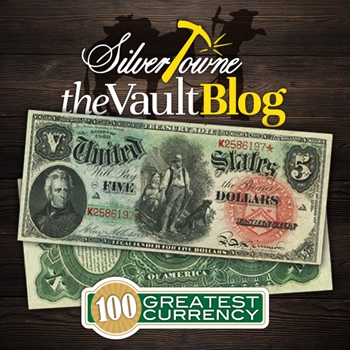
Landing in the middle of the pack and the focus of our series today is a currency note that graces Whitman Publishing’s 100 Greatest American Currency Notes with “colorful” vibrancy. With help from authors Q. David Bowers and David M. Sundman, we will dig deeper into this pleasing note that remains a favorite among collectors even today.
#47 - Series of 1869 $5 Legal Tender “Rainbow Note”
Just one of several denominations receiving the “Rainbow Note” designation, the $5 Legal Tender issue of Series 1869 features red serial numbers and a red Treasury seal atop a paper that is accented with a light blue tint vertically for a third of the note. A security precaution, the same blue tint paper was also used on some National Bank Notes and Fraction Currency. The portrait of the nation’s 7th President of the United States, Andrew Jackson, is featured on the face of the note in the bottom left corner. It was based on a painting by Thomas Sully that engraver Alfred Sealy used for the depiction.
The center of the face of the note features “The Pioneer Family” which was engraved by Henry Gugler. With his family behind him, the image showcases a frontiersman who holds an ax as he is thought to be building shelter. The image was chosen to represent the American West as the lands were still being settled. This motif was used for the $5 Legal Tender Series until the late 1920s although the back would change in 1907. Over 10 million notes were printed of the 1869 Rainbow Notes with just a 1,000 or more predicted to exist today.
President Jackson was particularly important in the world of finance and banking and took a stand against the Second Bank of the United States which operated from 1816 to 1836. Scandal and mismanagement would plague the bank, calling for Jackson to campaign against the bank in addition to his election for President. He would win both campaigns and private banking interests would breathe a sigh of relief at the removal of the federal banks.
This note in a Gem Crisp Uncirculated condition in 1960 was valued at $60. By 2005, the most current publication of Whitman Publishing’s book, it had risen to $3,800.







